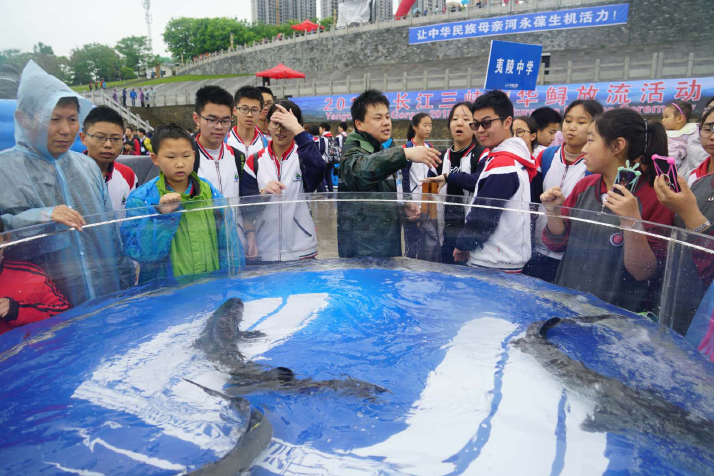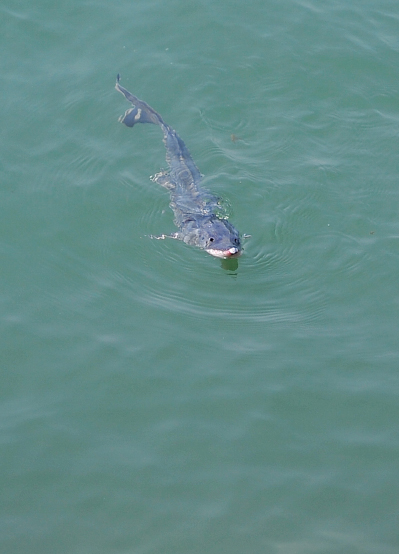|
||||||
|
||||||
| Home Nation World Business Opinion Lifestyle ChinAfrica Multimedia Columnists Documents Special Reports |
|
||||||
|
||||||
| Home Nation World Business Opinion Lifestyle ChinAfrica Multimedia Columnists Documents Special Reports |
| Nation |
| Swimming Upstream |
| An enterprise fulfills social responsibility and helps an iconic Chinese fish bounce back from the brink By Deng Yaqing |
| Deng Yaqing| NO. 18 MAY 3, 2018 |
 Volunteers prepare for the release of Chinese sturgeons into the Yangtze River in Yichang, central China's Hubei Province,on April 14
Wang Ziyi, a 14-year-old middle school student who lives in Yichang, central China's Hubei Province, can hardly conceal his excitement at laying his hand on the forehead of a Chinese sturgeon in a large temporary plastic fishpond. "It is the first time that I have seen a Chinese sturgeon, and they are gentler and meeker than I originally imagined," said Wang. In spite of his fondness for animals, Wang's parents have consistently refused his appeals to keep one at home due to his tight study schedule. "The observation of Chinese sturgeons helps me to more deeply feel the charm of nature," said Wang, while participating as a volunteer in the release of 500 Chinese sturgeons, an event designed and organized by the China Three Gorges Corporation (CTG) and local government departments. Such activities have been held 60 times to date, reintroducing more than 5 million individual fish into the wild.  A Chinese sturgeon swims in the Yangtze River XINHUA
Guaranteed survival As China's economic development has progressed, the country's policymakers have given priority to ecological restoration and protection. At the 19th National Congress of the Communist Party of China concluded in October 2017, Chinese President Xi Jinping noted that the restoration of the ecological environment along the Yangtze River is of great importance to the present and future, with a focus on all-round protection rather than large-scale exploitation. As ancient as the dinosaurs, Chinese sturgeon have swum in the earth's waterways since the Cretaceous Period some 140 million years ago. Adult fish usually weigh over 250 kg and exceed 4 meters in length. Born in the Yangtze River, infant sturgeons swim to the ocean where they reach full maturity before later returning to their place of birth to spawn. "The released sturgeons cover five age groups, with the eldest over 9 years old and fast reaching sexual maturity," said Jiang Wei, a research fellow with the Yichang-based Chinese Sturgeon Research Institute. Chinese sturgeons reach their reproductive age between 9 and 12 years old. On this occasion, every specimen was implanted with a sonar device, which will allow experts to find out how many of the released fish reach the sea and return to lay eggs in the future. "As wild Chinese sturgeons sharply decline in number, the ratio of females to males has increased to 7:1, implying a severe imbalance which could result in male sturgeons becoming extinct before female ones," said Jiang. Yet compared with Yangtze River dolphins which were declared extinct in 2007, Chinese sturgeons can lay roughly 600,000 eggs once, making it possible for artificial breeding and reproduction. "In fact, parthenogenetic reproduction techniques have been developed and are now sophisticated enough for application. Even if we can't capture any wild adult male individuals, the species can still realize multiplication," said Jiang. Throughout the course of its lifecycle, the Chinese sturgeon has to overcome a series of challenges, such as avoiding predators in the rivers and seas. In contrast, artificially bred fish bypass many of these dangers before being set free, their physique so big by the time they are fully grown that they have almost no natural predators, said Jiang, suggesting that the release program can greatly supplement the natural population of the species. According to the Chinese Sturgeon Research Institute, the proportion of released sturgeons passing through the estuary to reach the ocean has been 53.7 percent in recent years. "Advanced reproduction technology guarantees that the species will not disappear from the earth altogether, but whether or not the natural population of Chinese sturgeon falls to zero in the future depends on the water ecology and the environment of the Yangtze River," said Jiang. The construction of the Gezhou Dam in 1981 blocked the route along which Chinese sturgeons swim upstream to lay their eggs, and has been considered a significant factor in the current survival crisis. "In fact, the situation is far more complicated," said Jiang. Comprehensive protection As early as 1523, the sturgeon's return route to its breeding grounds was blocked by the collapse of a river bank, but the species did not immediately disappear from the Yangtze River. Even in the early years of construction on the Gezhou Dam, the fish arrived in droves to spawn nearby. In addition, sturgeons used to migrate up not just the Yangtze River, but the Yellow and Pearl Rivers too, while now only a few dozen naturally occurring fish can be found in the former, with none remaining in China's two other major waterways. "Overfishing is a major cause. As a result, exploitation has far outpaced reproduction. When the population of certain fish dwindles, other aquatic creatures that feed on them are also confronted with the threat of extinction, which is what has happened to the finless porpoise, often referred to as the 'smiling angel'," said Jiang. As regions along the Yangtze River have become more prosperous, ship engines and wastewater discharge from the agricultural and chemical sectors have also become culprits behind the decline of Chinese sturgeons, said Jiang. "Efforts should be made to curb overfishing and pinpoint the sources of pollution. More importantly, public awareness of ecological protection should be enhanced," said Li Kai, Director of External Affairs of The Nature Conservancy. "Just like the giant panda, the Chinese sturgeon is of symbolic significance. Protection should not be confined to this creature alone, but cover the whole ecology of the Yangtze River," said Li. In the past seven years, CTG has been carrying out ecological operations to reduce the negative impact of dams on the ecosystem. As a result, the natural reproduction rates of four major Chinese species of fish in the Yichang-Jianli section of the Yangtze soared by 50 times from 2011 to 2017. "As vital importance has been attached to ecological protection by Chinese policymakers, I have good reason to believe that each and every endangered species will be better valued and protected in the years to come," said Li. Copyedited by Laurence Coulton Comments to dengyaqing@bjreview.com |
About Us | Contact Us | Advertise with Us | Subscribe
|
||
| Copyright Beijing Review All rights reserved 京ICP备08005356号 京公网安备110102005860号 |